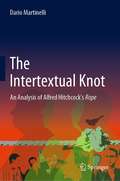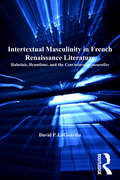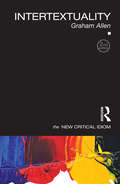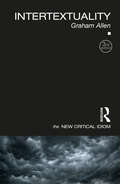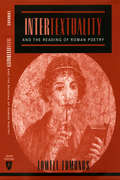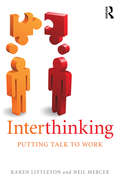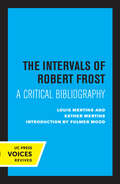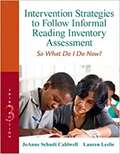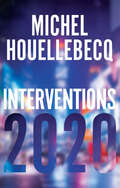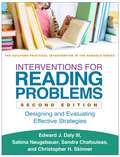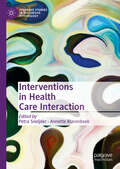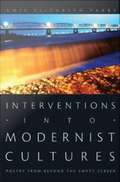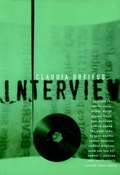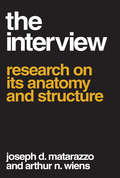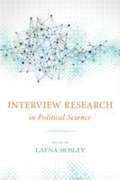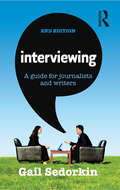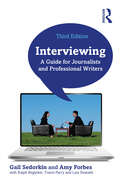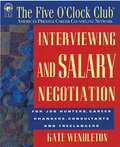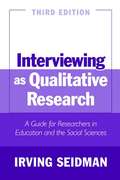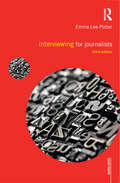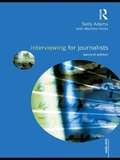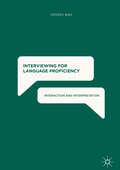- Table View
- List View
The Intertextual Knot: An Analysis of Alfred Hitchcock’s Rope
by Dario MartinelliThis book is a thorough analysis of Alfred Hitchcock's Rope (1948) and of its multiple connections with the Leopold and Loeb murder case and the adaptation of Patrick Hamilton’s eponymous play. As an all-encompassing portrait of the movie, the book discusses its aesthetics, style, role within cinema history, challenges in production, innovations introduced and of course Hitchcock’s signature features. However, as the analysis unfolds, the film reveals itself as an actual journey through the nightmares and the hopes that characterized the 20th century. Nazism and anti-Nazism, antisemitism, homophobia, democracy and totalitarianism, capital punishment and second chances, human rights, World War II, misogyny, tolerance and discrimination, Supermanism and humanism, artistic freedom and censorship. Subtly, often between the lines, and with Hitchcock's usual dark humor, Rope is nevertheless a much stronger social and political statement than it was ever given credit for. The Intertextual Knot is aimed at a varied readership, including film scholars, historians, philosophers and film enthusiasts.
Intertextual Masculinity in French Renaissance Literature: Rabelais, Brantôme, and the Cent nouvelles nouvelles (Women and Gender in the Early Modern World)
by David P. LaGuardiaIntertextual Masculinity in French Renaissance Literature is an in-depth analysis of normative masculinity in a specific corpus from pre-modern Europe: narrative literature devoted to the subject of adultery and cuckoldry. The text begins with a set of general questions that serve as a conceptual framework for the literary analyses that follow: why were early modern readers so fascinated by the figure of the cuckold? What was his relation to the real world of sexual behavior and gender relations? What effect did he have on the construction of actual masculinities? To respond to these questions, David LaGuardia develops a theoretical approach that is based both on modern critical theory and on close readings of records and documents from the period. Reading early modern legal texts, penance manuals, criminal registers, and exempla collections in relation to the Cent nouvelles nouvelles, Rabelais's Tiers Livre, and Brantôme's Dames galantes, LaGuardia formulates a definition of masculinity in this historical context as a set of intertextual practices that men used to relay and to reinforce their gender identities. By examining legal and literary artifacts from this particular period and culture, this study highlights the extent to which this supposedly normative masculinity was historically contingent and materially conditioned by generic practices.
Intertextuality (The New Critical Idiom)
by Graham AllenTheories of intertextuality suggest that meaning in a text can only ever be understood in relation to other texts; no work stands alone but is interlinked with the tradition that came before it and the context in which it is produced. This idea of intertextuality is crucial to understanding literary studies today. Graham Allen deftly introduces the topic and relates its significance to key theories and movements in the study of literature. The second edition of this important guide to intertextuality: outlines the history and contemporary use of the term incorporates a wealth of illuminating examples from literature and culture includes a new, expanded conclusion on the future of intertextuality examines the politics and aesthetics of the term relates intertextuality to global cultures and new media. Looking at intertextuality in relation to structuralism, post-structuralism, deconstruction, postcolonialism, Marxism, feminism and psychoanalytic theory, this is a fascinating and useful guide for all students of literature and culture.
Intertextuality (The New Critical Idiom)
by Graham AllenThis successful introduction to intertextuality deftly introduces this crucial area and relates its significance to key theories and movements in the study of literature. The third edition is updated to include a brand new chapter, looking at intermediality, and how the study of intertextuality has changed over the last ten years. Offering a clear guide to this crucial area, Graham Allen: outlines the history and contemporary use of the term incorporates a wealth of illuminating examples from literature and culture examines the politics and aesthetics of the term relates intertextuality to global cultures and new media Looking at intertextuality in relation to literary and critical theory as well as contemporary culture and media, this book offers a fascinating and useful approach to all aspects of literary studies, especially those dealing with adaptation, media, or comparative studies.
Intertextuality and the Reading of Roman Poetry
by Lowell EdmundsHow can we explain the process by which a literary text refers to another text? For the past decade and a half, intertextuality has been a central concern of scholars and readers of Roman poetry. In Intertextuality and the Reading of Roman Poetry, Lowell Edmunds proceeds from such fundamental concepts as "author," "text," and "reader," which he then applies to passages from Vergil, Horace, Ovid, and Catullus. Edmunds combines close readings of poems with analysis of recent theoretical models to argue that allusion has no linguistic or semiotic basis: there is nothing in addition to the alluding words that causes the allusion or the reference to be made. Intertextuality is a matter of reading.
Intertextuality in the English Translations of San Guo Yan Yi (China Perspectives)
by Wenqing PengSan Guo Yan Yi is one of the best-known classic Chinese novels in the English-speaking world. The earliest English translation came out in 1820, while a range of further translations have been produced over the past two hundred years. How do the different versions relate to each other? This volume examines the intertextual relations between the English translations of San Guo Yan Yi. Intertextuality refers to the interdependence of texts in relation to one another. Focusing on the perspectives of impact, quotation, parallels and transformation, the author compares a range of the translated versions, including two full-length translations and over twenty excerpted renderings and partial adaptations since the 1820s. She discovers that excerpted translations are selected to fit the translators’ own narrations, and are adapted to many genres, such as poetry, drama, fairytales, and textbooks. Moreover, the original text, translated texts and other related English works are interconnected in one large network, for which intertextuality offers an ideal basis for research. Students and scholars of Chinese literature and translation studies will benefit from this book.
Interthinking: Putting Talk To Work
by Neil Mercer Karen LittletonThrough using spoken language, people are able to think creatively and productively together. This ability to ‘interthink’ is an important product of our evolutionary history that is just as important for our survival today. Many kinds of work activity depend on the success of groups or teams finding joint solutions to problems. Creative achievement is rarely the product of solitary endeavour, but of people working within a collective enterprise. Written in an accessible and jargon-free style, Interthinking: putting talk to work explores the growing body of work on how people think creatively and productively together. Challenging purely individualistic accounts of human evolution and cognition, its internationally acclaimed authors provide analyses of real-life examples of collective thinking in everyday settings including workplaces, schools, rehearsal spaces and online environments. The authors use socio-cultural psychology to explain the processes involved in interthinking, to explore its creative power, but also to understand why collective thinking isn’t always productive or successful. With this knowledge we can maximise the constructive benefits of our ability to interthink, and understand the best ways in which we can help young people to develop, nurture and value that capability. This book will be of great interest to academic researchers, postgraduates and undergraduates on Education and Psychology courses and to practicing teachers. It will also appeal to anyone with an interest in language, creativity and the role of psychology in everyday life.
The Intervals of Robert Frost: A Critical Bibliography
by Louis Mertins Esther MertinsThis title is part of UC Press's Voices Revived program, which commemorates University of California Press’s mission to seek out and cultivate the brightest minds and give them voice, reach, and impact. Drawing on a backlist dating to 1893, Voices Revived makes high-quality, peer-reviewed scholarship accessible once again using print-on-demand technology. This title was originally published in 1947.
Intervention Strategies To Follow Informal Reading Inventory Assessment: So What Do I Do Now?
by JoAnne Caldwell Lauren LeslieThis one-of-a-kind book identifies practical reading intervention strategies based on students' informal reading inventory results. Today teachers need valid research-based measures for reading improvement, assessments to determine students' reading abilities, and intervention strategies to guide students back on track. To help teachers connect students' performance and evaluation to instruction, best-selling authors JoAnne Caldwell and Lauren Leslie outline practical intervention strategies that are aligned with any informal reading inventory. Targeting the latest research, this edition includes new student case studies, more writing applications, a focus on teaching with classroom materials, and a new PDToolkit (available either with the book or alone). By identifying intervention strategies based on assessment, the book helps teachers and students address difficulties in word identification, fluency, prior knowledge, and comprehension.
Interventions 2020
by Michel HouellebecqThe death of God in the West was the prelude to a formidable metaphysical soap opera that continues to this day. Christianity’s masterstroke was to combine a fierce belief in the individual with the promise of eternal participation in the Absolute. When that dream evaporated, various attempts were made to offer the individual a minimum of being. The latest of these attempts is advertising, which seeks to arouse desire and transform the subject into a docile phantom doomed to follow advertising’s every whim. But, like all previous attempts, this skin-deep, superficial participation in the world fails, and unhappiness and depression continue to spread.However, we can all produce a cold revolution in ourselves by stepping outside the flow of information and advertising. We need to take some time out, unplug the television, turn off our iPhones, stop buying stuff, stop wanting to buy stuff, temporarily detach ourselves and adopt an aesthetic attitude to the world. We just need to stay still for a few seconds.This is one of the key themes developed by Michel Houellebecq in this collection of his texts and interviews from the last three decades. Here he explains and elaborates his point of view, discusses his novels and addresses a wide range of topics from politics, religion and literature to suicide, euthanasia and paedophilia. An indispensable book for anyone interested in the work of one of the most widely read and controversial novelists of our time.
Interventions for Reading Problems, Second Edition
by Christopher H. Skinner Sabina Neugebauer Sandra Chafouleas Edward J. Daly IIIThis user-friendly guide has been thoroughly revised to reflect significant changes in the way schools deliver reading instruction and intervention, especially for students at risk for reading failure. Step-by-step strategies target key areas of literacy development: phonological awareness, fluency, and comprehension. Particular emphasis is placed on scientifically based practices that do not require major curricular change and can be applied with students of varying ages and ability levels. In a large-size format with lay-flat binding for ease of photocopying, the book includes 17 reproducible assessment and instructional tools. Purchasers also get access to a Web page where they can download and print the reproducible materials. New to This Edition: *Chapter on multi-tiered intervention delivery, plus additional discussion in other relevant chapters. *Chapter on interventions for English learners (ELs). *Chapter on vocabulary instruction, intervention, and assessment. *Additional graphing and data-analysis tools. *Coverage of new resources available through federal supports. This book is in The Guilford Practical Intervention in the Schools Series.
Interventions in Health Care Interaction (Palgrave Studies in Discursive Psychology)
by Petra Sneijder Annette KlarenbeekThis edited collection presents the latest work on the application of discursive psychology and conversation analysis to sensitive interactions and interventions in healthcare. While all interactions in healthcare settings can be challenging for both patients and practitioners, this book pays particular attention to topics that are likely to be especially sensitive, such as communication around sexual health, palliative care, suicide prevention, medically unexplained symptoms, or chronic pain. Across nine chapters authors discuss how discursive psychology and conversation analysis can help us understand what people actually do in conversations, hence providing a strong basis for developing and testing training methods that support health professionals to reflect on their interactions with patients. Addressing both practical and theoretical challenges in the development and implementation of such training sessions, this volume establishes the state-of-the-art in this area and offers a valuable tool for academics and researchers in discourse analytical fields, practitioners working to improve communication in health, as well as meeting facilitators in education or work settings related to healthcare.
Interventions Into Modernist Cultures: Poetry from Beyond the Empty Screen
by Amie Elizabeth ParryInterventions into Modernist Cultures is a comparative analysis of the cultural politics of modernist writing in the United States and Taiwan. Amie Elizabeth Parry argues that the two sites of modernism are linked by their representation or suppression of histories of U. S. imperialist expansion, Cold War neocolonial military presence, and economic influence in Asia. Focusing on poetry, a genre often overlooked in postcolonial theory, she contends that the radically fragmented form of modernist poetic texts is particularly well suited to representing U. S. imperialism and neocolonial modernities. Reading various works by U. S. expatriates Ezra Pound and Gertrude Stein, Parry compares the cultural politics of U. S. canonical modernism with alternative representations of temporality, hybridity, erasure, and sexuality in the work of the Taiwanese writers Y Kwang-chung and Hsia Y and the Asian American immigrant author Theresa Hak Kyung Cha. Juxtaposing poems by Pound and Y Kwang-chung, Parry shows how Y's fragmented, ambivalent modernist form reveals the effects of neocolonialism while Pound denies and obscures U. S. imperialism in Asia, asserting a form of nondevelopmental universalism through both form and theme. Stein appropriates discourses of American modernity and identity to represent nonnormative desire and sexuality, and Parry contrasts this tendency with representations of sexuality in the contemporary experimental poetry of Hsia Y. Finally, Parry highlights the different uses of modernist forms by Pound in his Cantos--which incorporate a multiplicity of decontextualized and ahistorical voices--and by Cha in her 1982 novel Dictee, a historicized, multilingual work. Parry's sophisticated readings provide a useful critical framework for apprehending how "minor modernisms" illuminate the histories erased by certain canonical modernist texts.
Interview
by Claudia DreifusThe interview is the DNA of journalism, the nucleus from which all life flows. Newspaper and magazine writers draw vital information, and sometimes inspiration, from government documents or corporate memos. These days, many journalists are chained to their computers, surfing the Internet for material. But it's all lifeless data without an interview, without going out to learn what real people think. Even if the reporter does nothing more than put a quick clarifying question to an expert on the phone, he is conducting an interview. And how he has thought out that question and worded it can spell the difference between producing something people will want to read or toss aside.
The Interview: Research on Its Anatomy and Structure
by Arthur N. WiensNearly two decades of research in clinic, industry, and educational settings have enabled the authors to present this compact but comprehensive report on the structure of the interview process. Joseph D. Matarazzo and Arthur N. Wiens have put together a concise presentation of research evidence; free from the dogged adherence to personal opinion that plagues most literature on the subject. The authors present and discuss basic interview concepts: interviewer and interviewee difference in interview behavior, the stability of such behavior, and conditions, which may modify it (including the first solid evidence, independently cross validated by others, for the effect on the interviewee of specific and common interviewer tactics).The book contains a wealth of data on differences in the interview speech behavior of different types of patients, and between persons in different occupations, different administrative hierarchies, and different professional specialties (for example surgical versus psychiatric nurses). Data from the clinical setting also includes evidence for a new and heretofore unsuspected process variable; i.e., a synchrony in the interruption behavior of the therapist and his patient over many psychotherapy sessions.The undergraduate in the communications fields will find this book an excellent adjunct to any of a number of courses in his special curriculum. Graduate students will find a storehouse of leads for theses and dissertations; while the practitioner and teacher in these fields will find much that is new and important to him in each chapter.
Interview Research In Political Science
by Layna MosleyInterviews are a frequent and important part of empirical research in political science, but graduate programs rarely offer discipline-specific training in selecting interviewees, conducting interviews, and using the data thus collected. Interview Research in Political Science addresses this vital need, offering hard-won advice for both graduate students and faculty members. The contributors to this book have worked in a variety of field locations and settings and have interviewed a wide array of informants, from government officials to members of rebel movements and victims of wartime violence, from lobbyists and corporate executives to workers and trade unionists. The authors encourage scholars from all subfields of political science to use interviews in their research, and they provide a set of lessons and tools for doing so. The book addresses how to construct a sample of interviewees; how to collect and report interview data; and how to address ethical considerations and the Institutional Review Board process. Other chapters discuss how to link interview-based evidence with causal claims; how to use proxy interviews or an interpreter to improve access; and how to structure interview questions. A useful appendix contains examples of consent documents, semistructured interview prompts, and interview protocols. Contributors: Frank R. Baumgartner, The University of North Carolina at Chapel Hill; Matthew N. Beckmann, University of California, Irvine; Jeffrey M. Berry, Tufts University; Erik Bleich, Middlebury College; Sarah M. Brooks, The Ohio State University; Melani Cammett, Brown University; Lee Ann Fujii, University of Toronto; Mary Gallagher, University of Michigan; Richard L. Hall, University of Michigan; Marie Hojnacki, Pennsylvania State University; David C. Kimball, University of Missouri, St. Louis; Beth L. Leech, Rutgers, the State University of New Jersey; Julia F. Lynch, University of Pennsylvania; Cathie Jo Martin, Boston University; Lauren Maclean, Indiana University; Layna Mosley, The University of North Carolina at Chapel Hill; Robert Pekkanen, University of Washington; William Reno, Northwestern University; Reuel R. Rogers, Northwestern University
Interviewing: A guide for journalists and writers
by Gail Sedorkin'The quintessential catch-all of journalism interviewing with tips, techniques and tales covering all interviewing forms in one easy-to-read volume.' - Leo Bowman in Australian Studies in JournalismGood interviewing is the key to good reporting and great stories. It's a difficult skill to acquire and it can be stressful, but you can learn how to approach a total stranger and elicit information on a topic about which you know nothing.In the second edition of this widely used guide, experienced journalist Gail Sedorkin shows you step by step how to manage the interview process. She explains how to prepare, and what to do when you don't have time to do any research. She outlines the difference between 'soft' and 'hard' interviews, how to use digital tools effectively, and how to make the most of any interview situation.With tips and examples from leading journalists, and covering basic to advanced techniques, Interviewing is an essential guide for journalists, researchers and writers.
Interviewing: A Guide for Journalists and Professional Writers
by Gail Sedorkin Amy ForbesThis is an essential guide to the art of interviewing, with checklists, tips and examples from leading journalists and PR specialists, covering basic to advanced techniques. Sedorkin and Forbes provide a comprehensive, step-by-step overview of how to manage the interview process. They cover: best practice for preparing for an interview (and what to do when you don’t have time to); the differences between news and feature interviews (for print and broadcast); techniques to break the ice and navigate tricky and sensitive interviewees and topics; tips on staying safe when operating in dangerous situations; how best to utilise digital tools to make the most of any interview situation. This third edition builds on the popular previous edition and expands its scope to include the disciplines of public relations and professional writing, areas where practitioners require the interviewing skills of journalists to produce materials for the media. It also contains new and updated global examples/case studies and excerpts, including remote interviewing technologies and techniques developed and adopted as a response to the disruptions of the COVID-19 pandemic. Additional pedagogical features have been added to help facilitate learning, like end of chapter exercises, checklists, videos and top tips. This book provides the tools for students and professionals to hone the necessary skill set to excel at interviewing. It is an ideal and important resource for those studying or active in the fields of journalism and PR, and those undertaking professional writing courses.
Interviewing And Change Strategies For Helpers: Fundamental Skills And Cognitive Behavioral Interventions
by Paula S. Nurius Cynthia J. Osborn Sherry CormierThis respected text skillfully combines evidence-based interviewing skills and cognitive-behavioral intervention change strategies applicable to a wide range of client ages, cultural backgrounds, and problems in living. The book interweaves attention to conceptual and empirical foundations with an emphasis on practical skills and real-life factors in contemporary settings with diverse clientele. Long commended for its synthesis of up-to-date professional knowledge with case models, learning activities, and guided feedback, INTERVIEWING AND CHANGE STRATEGIES FOR HELPERS: FUNDAMENTAL SKILLS AND COGNITIVE BEHAVIORAL INTERVENTIONS, Sixth Edition, features a new streamlined and reader-friendly design, as well as essential new information on vital topics such as ethics, critical thinking, client resistance, exposure therapy, the helping relationship, and recent developments in cognitive behavior therapy. These valuable additions complement a proven instructional format focusing on essential knowledge, skills, values, and tools needed by today's professional helpers.
Interviewing And Salary Negotiation
by Kate WendletonINTERVIEWING AND SALARY NEGOTIATION will help you: Meet with the right people...Beat the competition...and Negotiate the best salary-whether you're looking for $20,000 or $500,000. You got the interview; now what do you do? How do you turn that great networking meeting into a job lead? Would you like to get the most by mastering the "Four-Step Salary Negotiation Method"? What's the best way to make sure the job you're offered is the job you really want? INTERVIEWING AND SALARY NEGOTIATION is for every job hunter who wants to ace the interview...to turn that interview into a job offer...and to maximize the salary offer. INTERVIEWING AND SALARY NEGOTIATION teaches you how to: Gain more power in the job interview. Find out who your competitors are and how you stack up. Use the follow-up checklist to turn interviews into offers. Start out on the right foot in your new job. INTERVIEWING AND SALARY NEGOTIATION is based on the highly successful methods used at The Five O'clock Club, America's Premier Career Counseling Network, where the average participant finds a new job in less than 10 weeks. Kate Wendleton, a nationally syndicated careers columnist, is an authority on job search and career development. Kate has been a career coach since 1978 when she founded The Five O'Clock Club to help job hunters, career changers, and consultants at all levels. She is also the founder of Workforce America, a not-for-profit organization serving adult job hunters in Harlem who are not yet in the professional or managerial ranks. A former CEO of two small companies, Kate has twenty years of business experience as well as an MBA.
Interviewing as Qualitative Research: A Guide for Researchers in Education and the Social Sciences (3rd edition)
by Irving SeidmanThe third edition of this bestselling resource provides clear, step-by-step guidance for new and experienced interviewers to help them develop, shape, and reflect on interviewing as a qualitative research process.
Interviewing For The Helping Professions: A Comprehensive Relational Approach
by Fred McKenzie Nicole NicoteraA successful professional interview depends on the development of a generally positive human interaction. Without a positive base, the interview can be fraught with difficulties and roadblocks. This is true regardless of the discipline, be it social work, psychology, human services, nursing, criminal justice, medicine, psychiatry, or any other field. Beginning interviewers may have learned solid technique, but often are initially focused more on thinking about what they will say next than on understanding or even listening to the client. As a result, that critical initial interview -- whose success affects the future of most professional encounters -- is often disrupted by a failure to truly listen and understand, which is the foundation for earning clients' trust. This second edition goes beyond most other clinical interviewing books in its emphasis on the emotional foundation of interviewing and its focus on the importance of social justice and attention to the problem of microaggressions that can prohibit building and maintaining therapeutic rapport with clients. Interviewing for the Helping Professions can help both the beginning professional and the veteran interviewer understand the nature and purpose, technique, meaning, emotions, and outcomes of the interviewing process. The book also provides a comprehensive overview of the theory and technique so crucial to meaningful interviewing. More important, it emphasizes the emotional significance of the interaction and grounds the interviewing process in contemporary theories of practice and social justice.
Interviewing for Journalists
by Emma Lee-PotterInterviewing for Journalists focuses on the central journalistic skill of how to ask the right questions in the right way. It is a practical and concise guide for all print and online journalists – professionals, students and trainees – who write news stories and features for newspapers, magazines and online publications. In the age of digital journalism, where computer-based research is easily available, this new edition seeks to emphasise the value of getting out there, engaging with people directly and building relationships to create original and meaningful media content. Interviewing for Journalists highlights the many different approaches to interviewing, from vox pops and press conferences to news interviews and in-depth profiles. This third edition features brand new interviews with some of the most successful journalists in the industry, including Camilla Long of The Sunday Times, Heidi Blake of BuzzFeed UK, Brian Viner of the Daily Mail and award-winning freelance writers Cole Moreton and Stephanie Rafanelli. It covers every stage of interviewing, such as research, fixing interviews, structuring questions, body language, how to get vivid quotes and how to handle challenging interviews. The third edition of Interviewing for Journalists includes: advice on how to carry out face-to-face, telephone and online interviews; tips on taking notes, shorthand and recording interviews; guidance on dealing with different interviewees, such as celebrities, politicians and vulnerable people; interviewing tasks to put your journalistic skills into practice; a discussion of ethical and legal issues by Professor Tim Crook of Goldsmiths, University of London.
Interviewing for Journalists
by Adams SallyInterviewing for Journalists details the central journalistic skill of how to ask the right question in the right way. It is a practical and concise guide for all print and online journalists - professionals, students and trainees - whether writing news stories or features for newspapers and magazines, print and web. Interviewing for Journalists focuses on the many types of interviewing, from the routine street interview, vox pop and press conference to the interview used as the basis of an in-depth profile. Drawing on previously published material and featuring interviews with successful columnists such as Emma Brockes, who writes for the Guardian and the New York Times and Andrew Duncan of Radio Times. Interviewing for Journalists covers every stage of interviews including research, planning and preparation, structuring questions, the importance of body language, how to get a vivid quote, checking material and editing it into different formats. Interviewing for Journalists includes: a discussion about the significance and importance of the interview for journalism advice on how to handle face-to-face interviewees with politicians, celebrities and vulnerable people advice on dealing with PRs how to carry out the telephone and online interview tips on note-taking and recording methods including shorthand a discussion of ethical, legal and professional issues such as libel, doorstepping, off-the-record briefings and the limits of editing a glossary of journalistic terms and notes on further reading.
Interviewing for Language Proficiency
by Steven J. RossThis book analyses oral proficiency interviews, a mainstay of second language speaking proficiency assessment for several decades. Adopting a mixed-method perspective involving micro-analytic approaches, discourse analysis and quantitative methods such as multi-level modeling and event history analysis, the author focuses on interaction and discourse processes common in language assessment interviews. This innovative book will appeal to students and scholars of language assessment, conversation and discourse analysts, as well as practitioners and providers of oral proficiency assessment.
